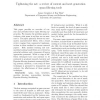Free Online Productivity Tools
i2Speak
i2Symbol
i2OCR
iTex2Img
iWeb2Print
iWeb2Shot
i2Type
iPdf2Split
iPdf2Merge
i2Bopomofo
i2Arabic
i2Style
i2Image
i2PDF
iLatex2Rtf
Sci2ools
COMPSEC
2006
2006
Tightening the net: A review of current and next generation spam filtering tools
This paper provides an overview of current and potential future spam filtering approaches. We examine the problems spam introduces, what spam is and how we can measure it. The paper primarily focuses on automated, non-interactive filters, with a broad review ranging from commercial implementations to ideas confined to current research papers. Both machine learning and nonmachine learning based filters are reviewed as potential solutions and a taxonomy of known approaches presented. While a range of different techniques have and continue to be evaluated in academic research, heuristic and Bayesian filtering dominate commercial filtering systems; therefore, a case study of these techniques is presented to demonstrate and evaluate the effectiveness of these popular techniques.
| Added | 11 Dec 2010 |
| Updated | 11 Dec 2010 |
| Type | Journal |
| Year | 2006 |
| Where | COMPSEC |
| Authors | James Carpinter, Ray Hunt |
Comments (0)

